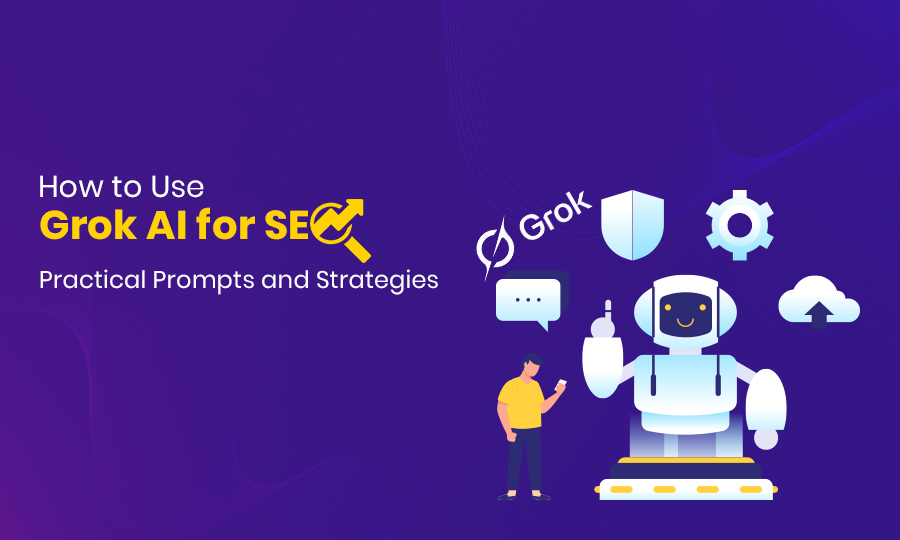The digital landscape is shifting beneath our feet, and Grok AI for SEO isn’t just another tool—it’s your competitive advantage in the age of AI-driven search. While marketers scramble to understand how AI is rewriting the rules of organic visibility, smart strategists are already using Grok AI SEO to dominate search results before their competitors even realize the game has changed.
Here’s the truth: traditional SEO strategies are becoming obsolete as AI models fundamentally redefine how information is discovered, ranked, and delivered. Now, your content competes not only for rankings but also for AI citations and recommendations thanks to Google’s AI Overviews, ChatGPT’s search integration, and Grok’s real-time data synthesis. 80% of consumers rely on “zero-click” results in at least 40% of their searches, so if you’re not optimizing for AI engines, Google won’t see you. This comprehensive guide reveals exactly how to use Grok’s power through actionable prompts and proven strategies that transform your SEO approach from guesswork to precision—giving you the blueprint to stay ahead while others fall behind.
What Is Grok AI for SEO and Why Is It Important?
Grok is an AI chatbot developed by xAI, the artificial intelligence company founded by Elon Musk. It is designed to work inside X (formerly Twitter) and can answer questions, generate content, analyze trends, and pull real-time information directly from X’s live posts something most other AI chatbots can’t do.
Grok AI for SEO is an artificial intelligence tool that helps optimize content through AI-driven keyword research, content generation, and automated SEO reporting. It uses real-time data integration and natural language processing to analyze search trends, create SEO-optimized content, and adapt strategies for AI-powered search platforms. It will increase organic visibility and rankings.
The Significance of Grok AI for SEO
Let’s see some proven facts that show the importance of Grok AI for search engine optimization-
- Rapid Growth: In 2025, Grok saw an amazing 13,434% year-over-year increase in traffic, with over 319,500 media mentions and 57.2 million monthly hits.
- Enhanced User Engagement: Almost 30.1 million monthly active Grok users spend an average of 14 minutes per visit, viewing 3.9 pages on Grok.com, indicating deep interaction with its content.
- SEO Advantages: Grok’s integration with X finds trending topics in Grok responses within hours, giving it an edge over traditional SEO methods.
- AI Search With Real-Time Data
Grok AI uses real-time data from the X platform to deliver AI-powered and direct answers to user queries. You can ask Grok AI search questions in a conversational way, and it will give you quick answers instead of long lists of results. This provides accurate, context-based results, which increases user satisfaction and extends the time that human visitors spend on a website.
- Grok AI and SEO Integration
Grok SEO and AI SEO link content marketing, schema markup, and structured data to make sure that useful content can be found using AI overviews. AI SEO services can optimize their blog posts and long-form content so that Grok sees them as authoritative sources when presenting Grok’s results.
- AI Models and Reasoning Abilities
Grok AI is based on powerful large language models and applies deep reasoning to understand complex queries and provide precise AI responses. This advanced technology allows Grok to interpret user queries more quickly and share significant information promptly.
- Role in AI Development and Grok AI SEO Services
You can use Grok AI’s “think mode” to really look into data trends, keep an eye on brand mentions, and make a plan for how to get more organic traffic. It helps SEO strategies to maintain a clear focus, align brand voice, and stay ahead in the future of artificial intelligence–driven search results.
How Is Grok Different from Other AI Models & Traditional Search Engines?
| Feature / Aspect | Grok AI | ChatGPT | Claude | Bing Copilot |
| Primary Function | Provides real-time AI search and conversational answers on the X platform. Pulls real-time data from posts, trends, and structured sources. | Generates text based on a large language model (LLM) trained on diverse internet data. Limited real-time data access unless connected to plugins. | Focuses on safe and helpful conversation using Anthropic’s LLM. Handles reasoning and summarization well but lacks live social feed access. | Integrates with Microsoft Bing search. Provides AI-powered answers with links, but search results may lag behind live trends. |
| Real-Time Search | Yes. Grok pulls current events and trending posts from the X platform instantly. | No. Data may be outdated depending on the model cut-off. | No. Responses rely on training data; limited real-time access. | Partial. Uses Bing search updates; not fully integrated with live social data. |
| Tone & Interaction | Feels human and conversational. Matches casual and professional styles depending on the query. | Neutral and informative. Flexible in tone, less personalized. | Polite and safe. Focuses on clear reasoning, avoids bias. | Formal and informative. Structured like search results with optional natural language. |
| Tools & Plugins | Can summarize posts, track brand mentions, and analyze trends within AI search. | Supports plugins for research, summarization, and code generation. | Minimal external tools; focuses on reasoning. | Connects to Office tools, search, and web plugins. |
| Versions | Grok 4 is the latest model. Offers improved reasoning, AI-powered summaries, and better structured data recognition. API access is available for SEO services and content marketing teams. | ChatGPT 4 (latest) supports advanced reasoning, multi-turn conversation. API is widely available. | Claude 3 is the latest; it focuses on safety and conversational clarity. | Continuously updated Bing AI; no separate version numbers publicly. |
| SEO Relevance | High. Optimized content can appear in AI overviews and Grok AI search, giving a first-mover advantage. Supports Grok AI SEO services and structured content. | Medium. Useful for content creation, keyword ideas, but limited real-time citation. | Low to medium. It can produce content, but no direct SEO integration. | Medium to high. Supports AI-enhanced content discovery but depends on Bing ranking. |
Grok SEO vs Traditional SEO: Key Differences
| Aspect | Grok AI SEO | Traditional SEO | Why It Matters |
| Core Focus | Focuses on AI search visibility, conversational understanding, and real-time data accuracy. | Focuses on keyword ranking, backlinks, and on-page optimization. | Grok SEO aligns with how AI engines interpret user intent and context. |
| Data Source | Pulls real-time data from the X platform and web sources. | Relies on indexed pages and periodic crawls. | AI-driven SEO stays fresher and more dynamic. |
| Content Format Preference | Prefers Q&A, FAQ, and conversational structures that match user queries. | Prefers keyword-rich, hierarchical content (H1–H3). | Grok rewards content that answers questions directly. |
| Ranking System | Prioritizes context, accuracy, and structured data understanding rather than link-based rankings. | Uses link equity and keyword density as primary ranking factors. | AI SEO measures relevance and reasoning, not just links. |
| Structured Data Usage | Relies heavily on schema markup (FAQPage, Article, Product) for clear interpretation. | Schema is optional — mainly for rich results. | Grok uses schema to extract AI answers in real time. |
| AI Integration | Works within AI Overviews, chatbot arena, and Grok search results. | Works within search engine result pages (SERPs) like Google or Bing. | AI SEO expands visibility beyond traditional SERPs. |
| Content Update Frequency | Needs continuous updates due to real-time access. | Can perform with quarterly or yearly updates. | Grok values fresh and current content. |
| Measurement Metrics | Tracks AI citations, AI overview mentions, and engagement depth. | Tracks CTR, ranking position, and organic clicks. | Grok SEO focuses on AI discoverability and contextual authority. |
| User Experience Approach | Optimizes for human + AI readers — combining readability and structured precision. | Optimizes mainly for human readers and keyword scanners. | Dual optimization ensures higher user satisfaction and AI trust. |
| Content Goal | Provides direct, data-backed AI answers and conversational insights. | Aims to rank on Google’s first page through optimization signals. | Grok SEO focuses on answering, not just ranking. |
How Can You Optimize Your Content for Grok AI Search?
Grok AI works like a digital researcher instead of ranking things based on links like Google does. When Grok sees your content, it examines semantic relevance, contextual depth, factual accuracy, and real-time freshness. Standard search engines rely on things like backlinks and domain authority to find results. Grok, on the other hand, uses advanced natural language processing to find results. It gives more weight to valuable content that directly answers complex questions with a clear structure and verified data.
The platform examines multiple layers: entity recognition, topical coherence, answer completeness, and citation-worthiness. Grok integrates real-time data, predictive context, and natural language reasoning to determine which content deserves exposure in AI answers. This means your content must display expertise, provide comprehensive coverage, and maintain accuracy with current publication dates and updated statistics.
Content Optimization Strategy for Grok AI SEO
You can follow these important strategies to stay ahead in AI engine optimization:
- Structured Data and Schema Markup:
You need to use schema markup and FAQ formats extensively so Grok can extract precise AI answers efficiently.
Step-by-Step Guide to Implement Structured Data for Grok AI
Step 1: Understand What Structured Data Means
Structured data is a code format (usually JSON-LD) that helps search engines and AI models like Grok AI understand the content of your page. It gives structured information about things like products, frequently asked questions (FAQs), authors, or reviews, so that AI can easily understand it.
Example (Product Schema):
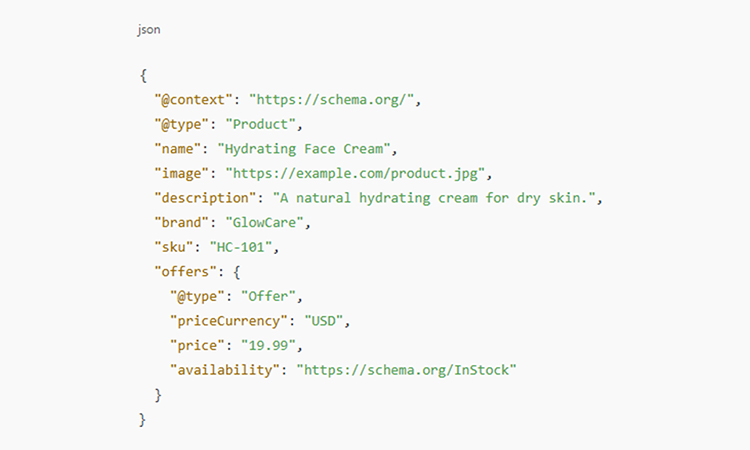
Step 2: Choose Schema Types That Work Best for Grok AI
For Grok AI SEO, you should prioritize schema types that improve AI reasoning capabilities and contextual visibility.
| Schema Type | Purpose | Why It’s Important for Grok AI |
| FAQPage | Answers questions directly | Grok uses the FAQ schema to extract clear, conversational answers for user queries |
| HowTo | Step-by-step instructions | Helps Grok structure AI answers for complex or tutorial-based searches |
| Article / BlogPosting | Identifies blog content | Improves AI overviews and content marketing visibility |
| Product | Describes product info | Enhances Grok AI search for e-commerce SEO |
| Organization | Defines brand info | Helps with brand mentions and trust-building |
| Review | Shows user feedback | Boosts user engagement and authority in AI engines |
Step 3: Validate Your Markup
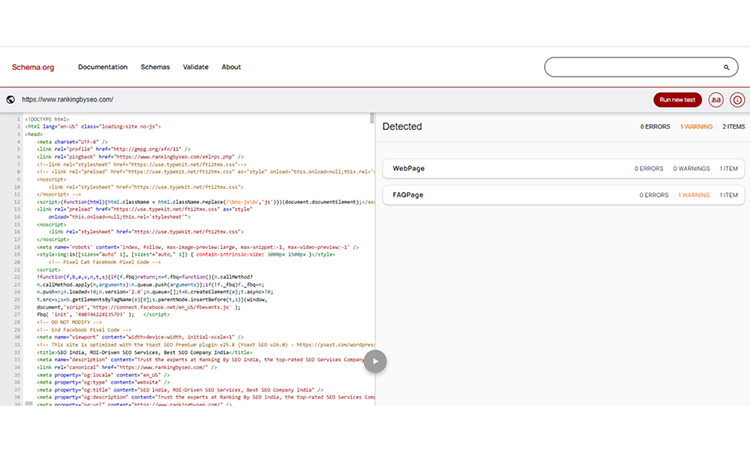
Then you can use Google’s Rich Results Test or Schema.org Validator to ensure your markup has no errors. Grok and other AI models prefer structured, error-free data for accurate content display. You can put your website URL and see the result.
Step 4: Keep It Updated With Real-Time Data
Grok pulls live information from the X platform and provides real-time access, so you need to update your schema regularly to match your latest content, publication dates, and product prices.
Best Schema Type for Grok AI SEO
If your main objective is to improve your Grok AI SEO performance and AI visibility, the FAQPage schema is the best to begin with.
It helps Grok AI with:
- Extract direct answers to conversational queries.
- Present your brand in AI overviews and chatbot responses.
- Increase organic traffic and user satisfaction.
- Conversational and Question-Based Framework: You can write in question-answer formats with a conversational tone that mirrors natural user queries. Grok prioritizes content matching how people actually search and ask complex questions. So, you need to break down topics into digestible sections with clear headings that address specific user intents. 45% of people think that educational content, such as “how-to” guides and step-by-step tutorials, will do the best. Another 37% think that content that compares and reviews things will also do well. So, you should write to educate people, not to sell any of your services or products. And also, you can develop “how-to ” guides to attract more organic traffic.
- Real-Time Accuracy and Freshness: Then you need to update your blog post content regularly with current data. Grok’s real-time integration with X and web sources means outdated information ranks significantly lower. Include recent statistics, trending insights, and time-sensitive information to maintain relevance.
- Topical Authority and Content Depth: Moreover, you can develop interconnected content clusters to show expertise across related topics. Then, you may write comprehensive guides, detailed tutorials, and in-depth reviews that prove your authority in your niche.
- Clear Structure and Readability: Grok considers content organization. So, you should use short paragraphs, bullet points, and subheadings, and maintain the logical flow. Your valuable content should be scannable for both AI engines and human readers.
How to Use Grok AI for Content Creation With AI-Powered Deep Dive?
- Most of the content marketers use Grok’s Deep Dive feature to conduct more thorough research than usual. So, you can begin your content creation process by prompting, “Perform a deep dive analysis on [specific topic], including competitor strategies, trending angles, audience pain points, and content gaps in the current market.”
- DeepSearch helps users find niche-specific solutions by analyzing competitors. Request detailed comparisons: “Compare the top 5 articles ranking for [target keyword] on both Google and AI platforms. Analyze their structure, depth, unique value propositions, and what makes them authoritative sources.”
- You can use these targeted prompts to generate valuable content: “Write an SEO-optimized 500-word section about [subtopic] targeting [primary keyword]. Include recent statistics from 2025, practical examples with step-by-step instructions, expert quotes, and a clear structure optimized for easy scanning by users and AI engines.”
Practical Grok Prompts for Content Optimization
For Comprehensive Blog Post Creation: “Analyze [your topic] trends and create a detailed blog post outline with a clear structure addressing the top 10 complex questions users ask. Include current data from 2025, trending keywords, and content gaps competitors miss.”
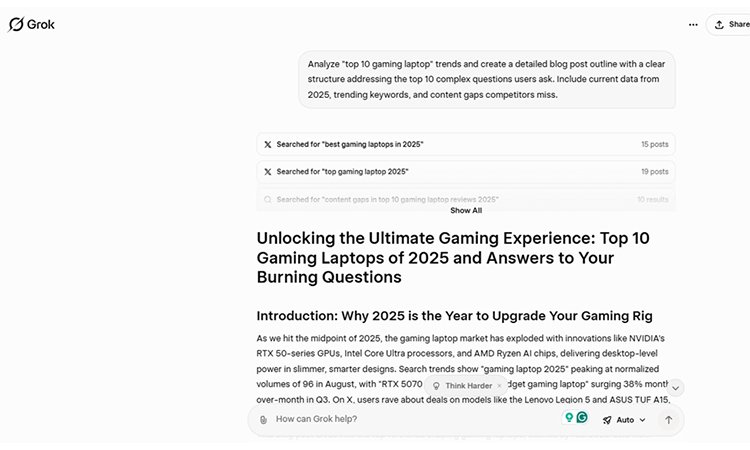
For Advanced SEO Enhancement: “Review this 2000-word article for Grok AI SEO optimization. Evaluate semantic relevance, keyword density, answer completeness, and readability. Suggest specific improvements for better AI visibility, including schema markup opportunities and content restructuring.”
For Strategic Keyword Research: “Identify high-intent keywords in [your niche] that generate valuable AI answers in chatbot arena platforms. Include long-tail variations, search intent analysis, monthly search volumes, and keyword difficulty scores. Focus on queries where users expect detailed responses.”
For Competitive Content Audits: “Evaluate this article’s performance against the top 5 ranking pieces on Google and AI search platforms. Provide specific recommendations covering content depth, unique angles, data freshness, and structural improvements.”
For Real-Time Trend Analysis: “What emerging topics in [your industry] are gaining traction this week? Identify content opportunities where search engines and AI engines show information gaps.”
Advanced Grok AI SEO Strategies for Dominating AI Engines
- Grok excels at automated SEO reporting and performance tracking, giving you competitive advantages. Regularly prompt: “Track mentions of [brand/topic] across social platforms and analyze sentiment patterns. Identify emerging content opportunities and user concerns that competitors haven’t addressed.”
- To compete with chatbot arena alternatives and stay visible across platforms, ask: “What [target keyword] content angles and question formats are competitors missing? Suggest 10 unique approaches that would provide superior value and earn citations in AI answers.”
- Moreover, you can use Grok for content gap analysis: “Analyze the content landscape for [industry topic]. Where are users asking complex questions that lack comprehensive, trustworthy answers? Prioritize opportunities by search volume and competition level.”
How Should You Write Headlines, Meta Descriptions for AI-Powered Overviews?
Grok AI, ChatGPT, and Gemini are examples of AI-powered overviews that require accuracy, clarity, and natural query alignment when creating headlines, meta descriptions. These components help AI models comprehend your subject and present your content as a reliable, condensed source.
- Write Headlines That Match AI Search Queries
- You need to use exact data, years, or entity-type words.
- The headline should be clear and matched with the content topic.
- Write in a format that answers a search-style query.
Prompt Template:
“Generate five SEO-optimized headlines using specific data or entities such as ‘[Year]’, ‘[Trend/Statistic]’, or ‘[Topic/Process] impact on [Outcome/Field]’.”
You can put your niche to generate headlines. I am creating headlines for a gaming company.
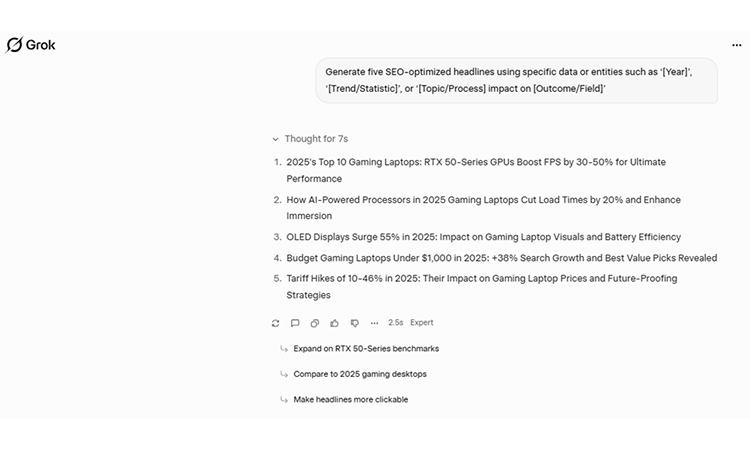
- Meta Descriptions
- Write concise answers that summarize the main intent.
- Include measurable data or a clear benefit.
- Use action verbs and natural question phrasing.
Prompt Template:
“Write meta descriptions that summarize the main insight with one verified fact or percentage, written in natural question-answer style.”
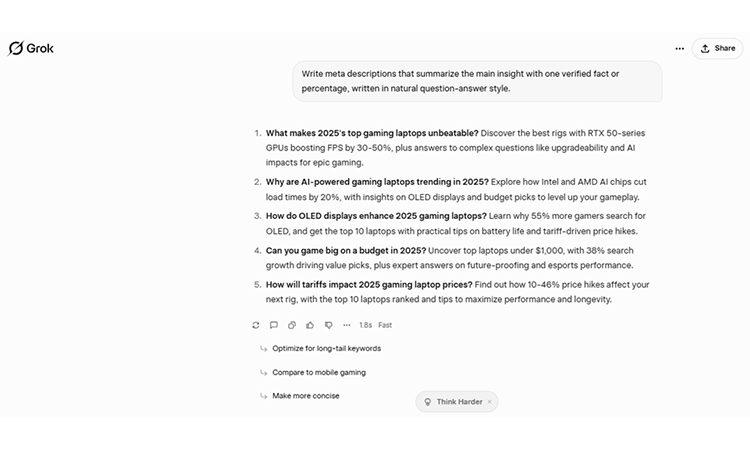
Example Format:
“Discover how [Process] improved [Result] by [Data]% in [Year]. Explore trends reshaping [Industry/Field].”
How to Measure Content Optimization Success and Stay Ahead?
You can request monthly reports:- “Analyze our content performance across search engines and AI platforms. Compare month-over-month growth in visibility, citations, and user engagement.”
If you really want to succeed with Grok AI SEO and AI-powered search, you need to track how well your content performs not only on Google but also across AI search platforms like Grok, ChatGPT, and Gemini.
Here’s how you can measure your optimization success and the best tools to stay ahead.
| Metric | What It Shows | Why It Matters for Grok AI SEO |
| Organic Traffic Growth | Number of visitors from search engines | Indicates how well your content ranks in both AI and traditional search |
| Click-Through Rate (CTR) | % of users clicking your internal link from search | Measures how appealing your AI-optimized title/meta is |
| User Engagement | Time on site, bounce rate, scroll depth | Reflects user satisfaction and content value |
| AI Search Mentions | How often does Grok or Gemini reference your brand | Tracks visibility in AI overviews |
| Backlinks & Brand Mentions | Number of authoritative links | Signals trustworthiness and helps with AI understanding |
| Conversion Rate | Leads, sales, or sign-ups | Shows how optimized your content funnel is |
Best Tools to Optimize Content for Grok AO SEO are-
You can take help from these tools to see how your content works and drive organic traffic or not.
- Clearscope
- NeuronWriter
- ContentKing
- Google Analytics 4 (GA4)
- Surfer SEO
Furthermore, you can focus on clarity, proven authority, and real-time value, and give complete answers to complex questions in your content strategy to match how Grok AI SEO works. This will help you dominate both traditional search engines like Google and new AI platforms, making sure your useful content reaches users at the perfect time.
What Are the Best Grok Artificial Intelligence Prompts for Keyword Research?
Keywords are those specific search terms that your users type to find your products or services. It is very important, so you need to carefully analyze them and put your content. Let’s explore how you can use Prompt to do keyword research with Grok AI.
- Primary Keyword Discovery
You need a thorough grasp of the keyword landscape in your niche before you begin your keyword research. This prompt provides a comprehensive foundation for building your content strategy.
Use This Prompt:
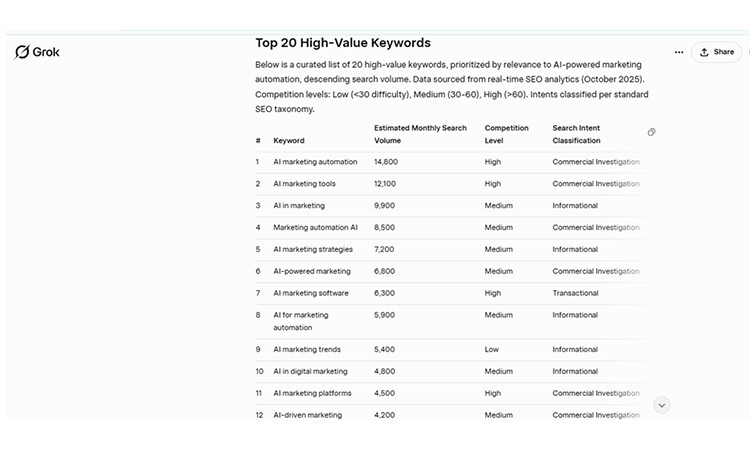
Analyze the keyword landscape for [AI-powered marketing automation]. Identify 20 high-value keywords with search intent classification, estimated search volume, and competition level. Focus on terms where AI-generated content performs well.
What You’ll Get: Grok will return a categorized list showing keywords like “AI marketing tools,” “automated email campaigns,” and “marketing automation software” with their search volumes, difficulty scores, and whether they’re informational, commercial, or transactional.
How to Use It: Take the high-volume, low-competition keywords and prioritize them for your content calendar. Focus on informational keywords for blog posts and commercial keywords for service pages.
- Semantic Keyword Expansion
Once primary keywords have been identified, you will need related terms to produce perfect content that Grok’s natural language processing system can recognize.
Use This Prompt:
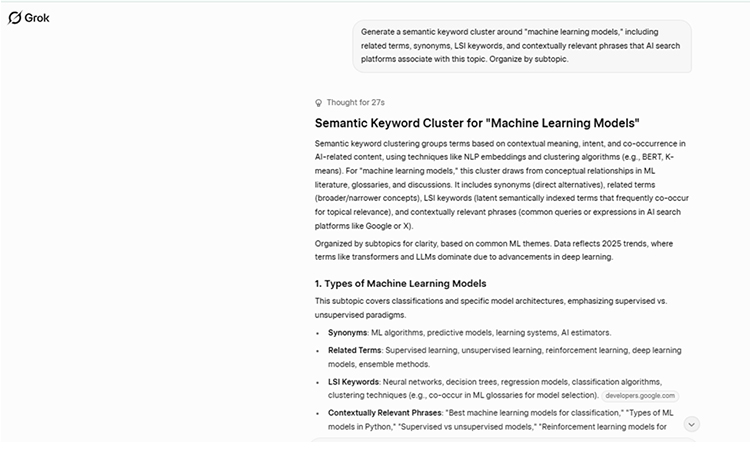
Generate a semantic keyword cluster around “machine learning models,” including related terms, synonyms, LSI keywords, and contextually relevant phrases that AI search platforms associate with this topic. Organize by subtopic.
What You’ll Get: A grouped list of related keywords like “neural networks,” “deep learning algorithms,” “model training,” “supervised learning,” and “AI model deployment” organized by subtopics such as training, deployment, and optimization.
How to Use It: Integrate these semantic keywords naturally throughout your content. Use them in subheadings, meta descriptions, and body text to demonstrate topical depth and improve AI comprehension.
- Long-Tail Keyword Discovery
Long-tail keywords convert better according to unique user intent and have lower competition, making them ideal for newer websites or specialized content pieces.
Use This Prompt:
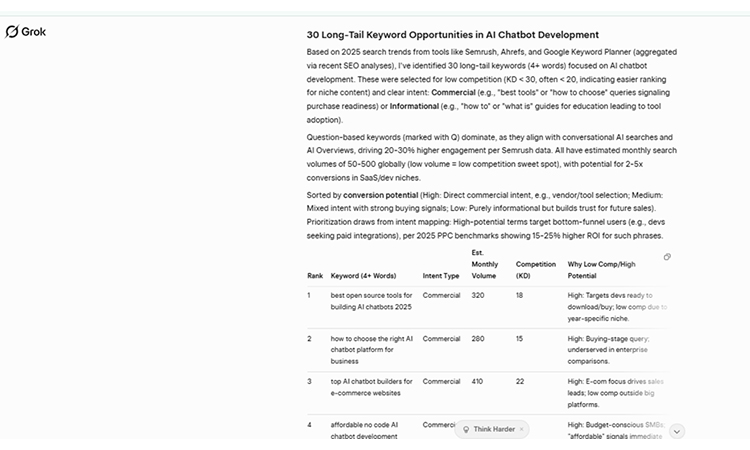
Identify 30 long-tail keyword opportunities (4+ words) in AI chatbot development that have low competition but clear commercial or informational intent. Include question-based keywords and sort by conversion potential.
What You’ll Get: Specific phrases like “how to build a customer service chatbot,” “best AI chatbot platforms for small business,” and “chatbot development cost for e-commerce” with intent classification and difficulty ratings.
How to Use It: Create dedicated blog posts or FAQ sections targeting these long-tail queries. They’re easier to rank for and attract users closer to making decisions.
- Voice Search & Conversational Keywords
With AI assistants becoming primary search tools, conversational keywords are increasingly important.
Use This Prompt:
What conversational, question-based long-tail keywords are people asking about neural network training? Focus on natural language queries used in voice search, AI assistants, and chatbot interfaces. Include “how,” “what,” “why,” and “when” questions.
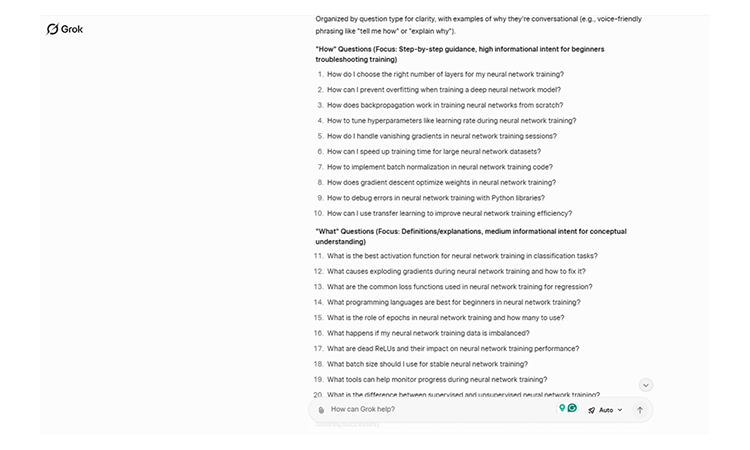
What You’ll Get: You get mostly asked questions and can put those in your content.
How to Use It: Structure your content in Q&A format. Use these exact questions as H2/H3 headings with direct answers following each question to maximize visibility in AI-generated responses.
- Competitor Strategy Analysis
You need to understand what works for competitors to help you identify proven opportunities and content gaps you can exploit.
Comprehensive Competitor Keyword Audit
Use This Prompt:
Analyze the top 5 competitors’ ranking for “AI SEO tools”—identify the keywords they’re targeting that I’m missing, their content gaps, weaknesses I can exploit, and unique angles they haven’t covered. Provide actionable recommendations.
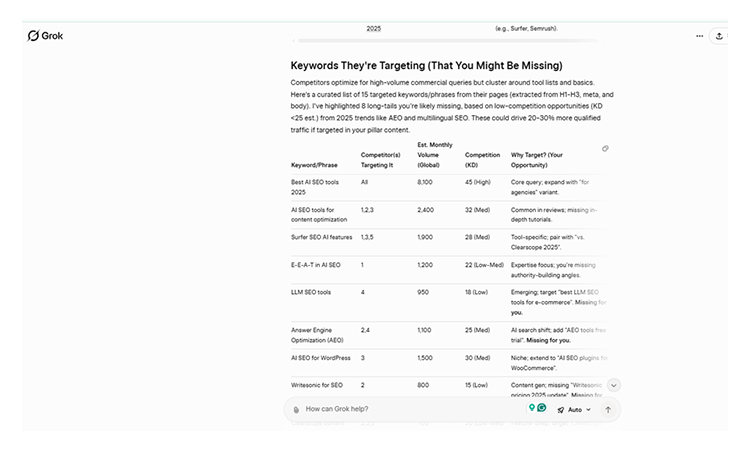
What You’ll Get: A detailed breakdown showing competitor keywords, their ranking positions, content types they use, topics they’ve covered, and—most importantly—gaps where they’re weak or missing content entirely.
How to Use It: You need to target the gaps first. Then create more comprehensive content than competitors for their weak topics. Identify patterns in their keyword strategies and adapt successful approaches.
- Keyword Gap Analysis
Use This Prompt:
Compare my website [yoursite.com] against [competitor.com] for the AI development niche. Identify keyword gaps where they rank on page 1 but I don’t appear in the top 50. Prioritize opportunities by search volume, ranking difficulty, and commercial value.
What You’ll Get: A prioritized list of keywords your competitor owns but you’re not targeting, ranked by potential impact and difficulty.
How to Use It: Focus on medium-difficulty keywords where the competitor ranks but doesn’t have exceptional content. Create superior, more comprehensive content targeting those specific terms.
- Trending Topic Identification
Grok’s real-time data integration makes it exceptional for identifying emerging trends before they become oversaturated. You can find
Real-Time Trend Discovery
Use This Prompt:
What are the fastest-growing search trends in artificial intelligence and machine learning over the past 30 days? Identify emerging keywords with rising search volume that present early-mover content opportunities. Include percentage growth rates.
What You’ll Get: Recently trending topics like “AI agents,” “multimodal AI,” or “AI regulation” with growth metrics showing which terms are gaining momentum.
How to Use It: Create timely content around these trending topics immediately. Being an early publisher on rising trends positions you as an authority and captures traffic before competition intensifies.
- Search Intent Analysis
You need to understand search intent to ensure your content matches what users actually want. It will improve rankings and engagement.
You can use This Prompt:
Analyze these keywords: [AI development tools, best AI frameworks, machine learning tutorial, hire AI developers, AI consulting services]. Classify each by search intent (informational, navigational, commercial, or transactional) and explain what content format best satisfies each intent.
What You’ll Get: Each keyword classified with specific content recommendations —”AI development tools” needs a comparison guide, “machine learning tutorial” needs step-by-step educational content, and “hire AI developers” needs service pages with case studies.
How to Use It: Match your content type to search intent. Don’t create blog posts for transactional keywords or service pages for informational queries. This alignment dramatically improves conversion rates and rankings.
What Are the Top Grok AI SEO Strategies for Technical Optimization?
Technical SEO is what makes Grok able to find, crawl, and understand your website. As AI models improve, technical optimization is crucial to making sure that your content is understandable by both conventional search engines and AI-powered platforms like Grok. This specific segment explores essential technical SEO services and practical implementation strategies specifically optimized for Grok AI.
Let’s Understand Technical SEO in the Grok AI Era.
Grok AI operates differently from traditional search engines by functioning as a digital researcher that needs to efficiently access, process, and evaluate your website’s technical infrastructure. When comparing site architecture to other programs, Grok uses advanced natural language processing. This means that technical issues that may not seem important can have a big effect on your visibility in AI-driven search results.
- Mobile Optimization for Grok AI SEO
Mobile optimization is essential for AI comprehension, as Grok supports mobile-first indexing in the same way Google does.
Implementation Steps:
Step 1: Responsive Design Audit – Prompt Grok: “Analyze my website [URL] for mobile responsiveness issues. Check viewport configuration, touch element spacing, and mobile usability problems. Provide specific CSS fixes.”
Key points to address:
- Viewport meta tags must be properly configured.
- Touch targets should be at least 48×48 pixels.
- Text must be readable without zooming (minimum 16px font size).
- Avoid horizontal scrolling.
Step 2: Mobile Performance Testing—You can use this prompt: “Evaluate mobile page speed for [URL]. Identify render-blocking resources, large images, and JavaScript issues affecting mobile load times. Suggest optimization priorities.”
Do you know that almost 53% of mobile users abandon sites that take longer than 3 seconds to load? So, this will give Grok clear technical signals about how well your mobile optimization is working, which helps it suggest your content to people who are using mobile devices.
Step 3: Mobile-Specific Schema Implementation—You can implement AMP (Accelerated Mobile Pages) or ensure your mobile pages load under 2.5 seconds. Like a local business schema with click-to-call functionality, structured data should be used in mobile settings.
Step 4: Test Across Devices Prompt: “What are the top 10 mobile devices and screen sizes I should test my site on? Provide specific resolution and viewport dimensions for comprehensive mobile testing.”
- Site Speed Analysis and Optimization
The budget for AI crawling is directly related to how fast a site loads. AI models pay 3 times more attention to websites that load in less than 2 seconds than to websites that take longer to load. This means that sites that load faster get searched more thoroughly, which makes sites that take longer to load a major problem.
Implementation Steps:
Step 1: Comprehensive Speed Audit
Grok Prompt—”Perform a deep technical analysis of [URL] page speed. Identify all performance bottlenecks, including server response time, render-blocking resources, image optimization opportunities, CSS/JavaScript issues, and third-party script impacts. Prioritize fixes by impact.”
Step 2: Core Web Vitals Optimization- You need to focus on the three key metrics:
- Largest Contentful Paint (LCP): Should be under 2.5 seconds
- First Input Delay (FID): Under 100 milliseconds
- Cumulative Layout Shift (CLS): Under 0.1
Prompt: “Review my Core Web Vitals scores for [URL]. Explain what’s causing poor scores and provide step-by-step fixes with code examples for improving LCP, FID, and CLS.”
Step 3: Create an image optimization strategy- Images make up 50–60% of a page’s total weight. Use this prompt: “Analyze all images on [URL]. Recommend optimal formats (WebP, AVIF), compression ratios, lazy loading implementation, and responsive image strategies. Include code snippets for implementation.”
Critical checklist:
- Convert images to modern formats. (WebP reduces file size by 30% vs. JPEG.)
- Implement lazy loading for below-fold images.
- Use srcset for responsive images.
- Add proper alt text for accessibility and AI understanding.
Step 4: Caching and CDN Configuration—Grok Prompt: “Design an optimal caching strategy for my website, including browser caching headers, CDN configuration, and cache invalidation policies. Provide specific cache-control directives.”
- Internal Linking Strategy Development
For Grok AI to understand your site’s knowledge structure, you need to develop subject authority through content that is linked to each other. AI models can use strategic internal link design to figure out how to map your content connections and distribute authority. Internal links can improve your site’s SEO performance by 5-10% when done right.
Implementation Steps:
Step 1: Content Cluster Mapping—Grok Prompt: “Analyze my website structure and identify opportunities for content clusters around [primary topic]. Suggest pillar pages, supporting content, and optimal internal link connections. Create a visual sitemap showing topical relationships.”
Step 2: Anchor Text Optimization– You can use descriptive, keyword-rich anchor text that helps search engines understand link context.
Prompt: “Review internal links on [URL]. Suggest improved anchor text that’s descriptive, contextually relevant, and includes target keywords naturally. Avoid generic phrases like ‘click here.'”
Key points for anchor text:
- Use 3-5 word descriptive phrases.
- Include target keywords naturally.
- Vary anchor text (don’t use identical text for every internal link).
- Ensure anchor text accurately describes destination content.
Step 3: Link Depth Analysis– Grok Prompt: “Calculate the click depth for all pages on my website. Identify orphaned pages and pages requiring more than 3 clicks from the homepage. Suggest internal link additions to improve crawl efficiency.”
Important pages should be accessible within 3 clicks from your homepage.
Step 4: Contextual Linking Strategy- Implement contextual links within the content body text rather than just navigation or sidebar links. These carry more weight with AI models.
Grok Prompt: “Review this article [URL] and suggest 5-8 contextual internal link opportunities. Identify relevant existing content that would add value and suggest natural placement points with anchor text recommendations.”
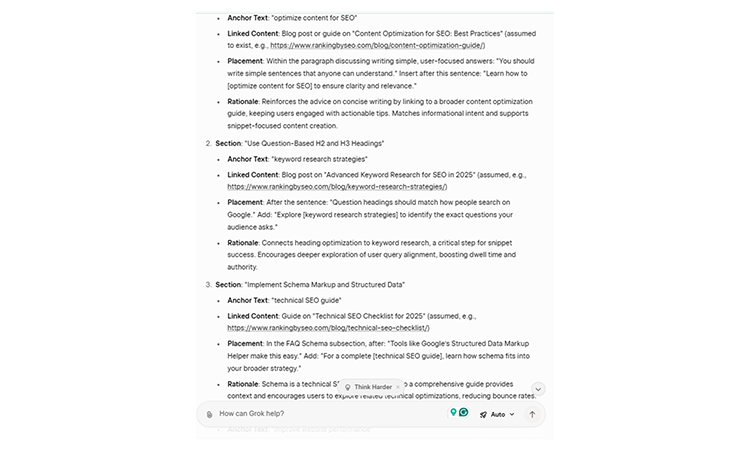
- Crawlability and Indexing Optimization
Furthermore, you need to remove technical barriers and provide a clear site architecture to help Grok crawl your site efficiently.
Implementation Steps:
Step 1: Robots.txt Optimization
Robots.txt optimization is the process of making changes to your website’s robots.txt file so that search engines and AI crawlers know which pages to scan and which to ignore. This makes browsing faster, content more visible, and SEO works better.
Prompt: “Review my robots.txt file for [domain]. Identify any rules blocking important content from AI crawlers. Suggest optimized rules that protect sensitive areas while ensuring complete crawlability of public content.”
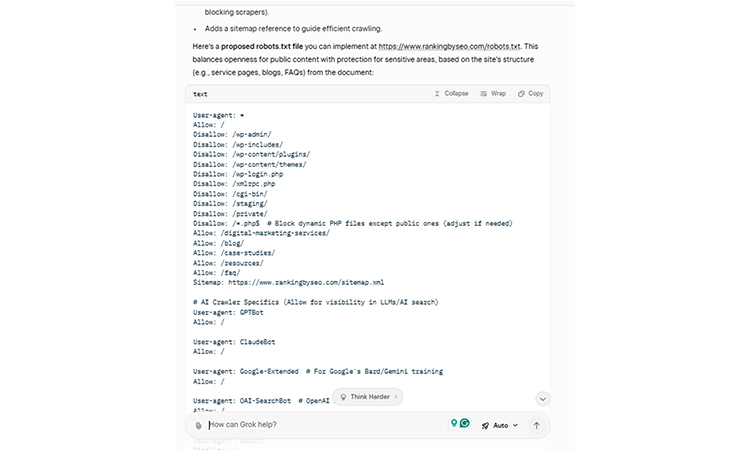
Your robots.txt should:
- Allow crawling of all public content.
- Block admin areas, search result pages, and duplicate content.
- Include sitemap location.
- Avoid blocking CSS, JavaScript, or image resources.
Step 2: XML Sitemap Enhancement –
XML sitemaps help search engines and AI models like Grok AI browse, understand, and index content for better AI search and SEO visibility.
Grok Prompt: “Generate an optimized XML sitemap structure for my website with [X] pages. Include priority values, change frequencies, and image/video sitemaps where applicable. Explain the proper submission process to search consoles.”
Best practices:
- Keep individual sitemaps under 50MB and 50,000 URLs.
- Use sitemap index files for larger sites.
- Update sitemaps automatically when content changes.
- Include lastmod dates for all URLs.
Step 3: Canonical Tag Implementation- An HTML canonical tag tells search engines which version of a webpage is the original or preferred one, preventing duplicate content and consolidating ranking signals for SEO accuracy.
Grok Prompt: “Audit [domain] for duplicate content issues. Identify pages needing canonical tags, parameter handling, and consolidation strategies. Provide implementation code.”
- Advanced Technical SEO Strategies for Grok AI
Step 1: JavaScript Rendering Optimization
Modern sites often rely heavily on JavaScript, which can create crawling challenges.
Prompt: “Evaluate JavaScript rendering on [URL]. Test if the content is accessible in the HTML source or requires JavaScript execution. Recommend server-side rendering (SSR) or static site generation (SSG) strategies if needed.”
Key implementation points:
- You need to make sure important information shows up in the original HTML.
- For JavaScript apps that are very complicated, use dynamic rendering.
- Set up the right fallbacks and waiting states.
Step 2: Log File Analysis
For technical problems, understanding how crawls really work is helpful.
Prompt: “Explain how to analyze server log files to identify Grok AI crawler behavior, crawl budget issues, and technical errors. What patterns should I look for?”
Monitor:
- Crawl frequency on important pages
- 404 errors and redirect chains
- Server response times for crawler requests
- Pages being crawled vs. ignored
Step 3: International SEO Configuration
A perfect technical setup is very important for global audiences.
Prompt: “Design international SEO architecture for [domain] targeting [countries/languages]. Recommend URL structure (subdirectories vs. subdomains), hreflang implementation, and content localization strategy.”
Step 4: Core Technical Health Monitoring
You can establish ongoing monitoring with this prompt: “Create a technical SEO monitoring checklist for weekly, monthly, and quarterly reviews. Include specific tools, metrics to track, and threshold values that indicate problems requiring immediate attention.” This checklist will help ensure that your website remains optimized for search engines and user experience.
How to Measure Technical SEO Success with Grok AI
You need to regularly use manual testing methodologies combined with automated monitoring to ensure your technical optimizations remain effective.
Prompt: “Design a comprehensive technical SEO dashboard tracking crawlability metrics, indexation rates, site speed scores, mobile usability, and Core Web Vitals. Suggest tools and reporting frequency.”
Track these KPIs:
- Crawl efficiency rate (pages crawled vs. total pages)
- Indexation percentage
- Average page load time (target: under 2 seconds)
- Mobile usability score
- Core Web Vitals passing rate (target: 75%+ pages passing)
- Internal link depth distribution
Frequently Asked Questions
ChatGPT, Gemini, and Grok AI are top AIs for SEO. They help create optimized content, research keywords, and improve search visibility effectively.
Grok AI focuses on real-time data from X, while ChatGPT offers deeper content creation and SEO support. Both perform well for different needs.
Yes, Grok AI can search the web and the X platform. It provides updated answers and real-time results for user questions.
Our Final Verdict
Grok AI is the most revolutionary AI tool to date, offering unparalleled capabilities in natural language processing and machine learning. Its advanced algorithms and user-friendly interface make it the top choice for businesses looking to simplify their operations and improve productivity.
So, at the end of our discussion of Grok AI for SEO, you have multiple practical Grok prompts to research keyword and content optimization and maintain technical SEO. So, implement these practical prompts and strategies to improve your brand’s visibility.

